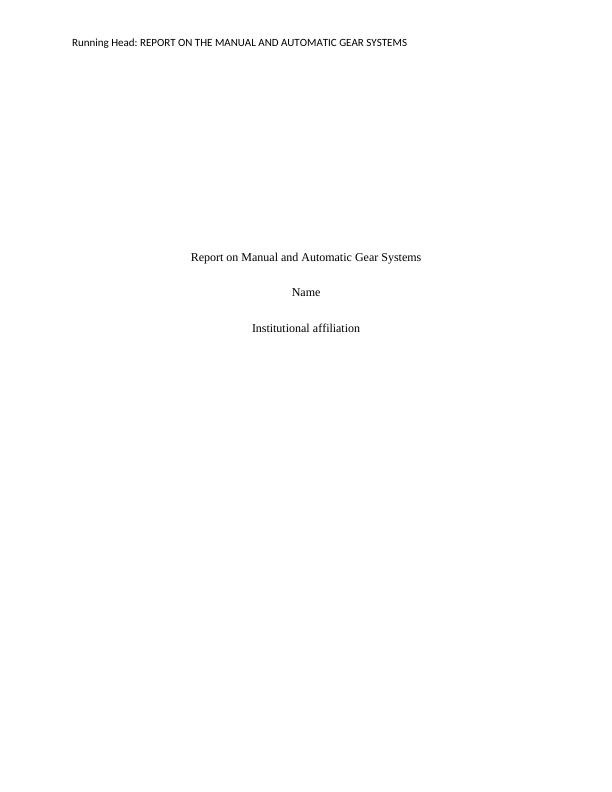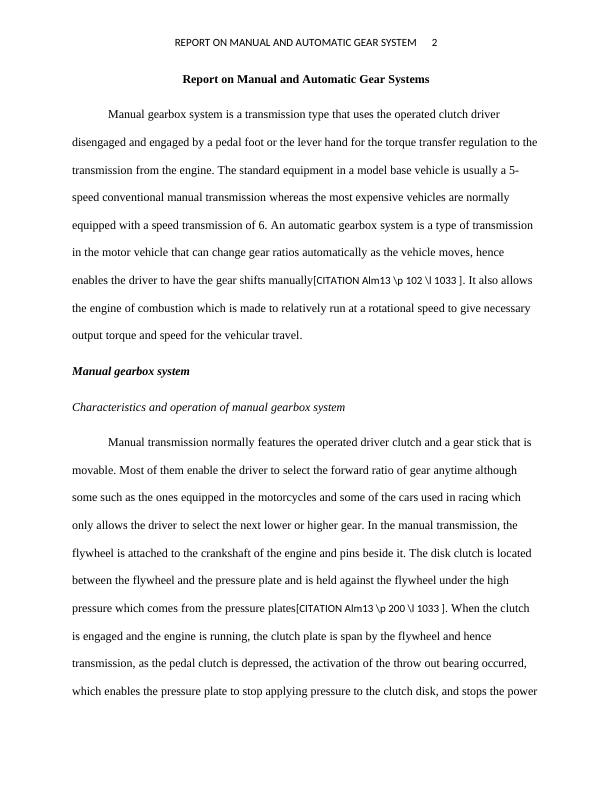Report On Manual and Automatic Gear System
11 Pages3383 Words546 Views
Added on 2020-04-01
Report On Manual and Automatic Gear System
Added on 2020-04-01
ShareRelated Documents
Running Head: REPORT ON THE MANUAL AND AUTOMATIC GEAR SYSTEMSReport on Manual and Automatic Gear SystemsNameInstitutional affiliation

REPORT ON MANUAL AND AUTOMATIC GEAR SYSTEM 2Report on Manual and Automatic Gear SystemsManual gearbox system is a transmission type that uses the operated clutch driver disengaged and engaged by a pedal foot or the lever hand for the torque transfer regulation to thetransmission from the engine. The standard equipment in a model base vehicle is usually a 5-speed conventional manual transmission whereas the most expensive vehicles are normally equipped with a speed transmission of 6. An automatic gearbox system is a type of transmission in the motor vehicle that can change gear ratios automatically as the vehicle moves, hence enables the driver to have the gear shifts manually[CITATION Alm13 \p 102 \l 1033 ]. It also allows the engine of combustion which is made to relatively run at a rotational speed to give necessary output torque and speed for the vehicular travel.Manual gearbox systemCharacteristics and operation of manual gearbox systemManual transmission normally features the operated driver clutch and a gear stick that is movable. Most of them enable the driver to select the forward ratio of gear anytime although some such as the ones equipped in the motorcycles and some of the cars used in racing which only allows the driver to select the next lower or higher gear. In the manual transmission, the flywheel is attached to the crankshaft of the engine and pins beside it. The disk clutch is located between the flywheel and the pressure plate and is held against the flywheel under the high pressure which comes from the pressure plates[CITATION Alm13 \p 200 \l 1033 ]. When the clutch is engaged and the engine is running, the clutch plate is span by the flywheel and hence transmission, as the pedal clutch is depressed, the activation of the throw out bearing occurred, which enables the pressure plate to stop applying pressure to the clutch disk, and stops the power

REPORT ON MANUAL AND AUTOMATIC GEAR SYSTEM 3to the clutch plate from the engine, so that shifting of gear can occur without damaging the transmission. When the clutch plate is released, the bearing throw out is deactivated, and the clutch disk is held again against the flywheel, enabling it to start getting power from the engine[CITATION Jac10 \p 69 \l 1033 ].Types and background of manual transmissionNon- synchronized transmissionThe earliest manual form of transmission is believed to have been invented by Emile Levasseur and joy clulow in the late 19th century, this gear types gave the multiple ratios of gear and mostly, reverse. The gears were engaged typically by sliding them on the shafts which need the throttle manipulation and the careful timing when shifting, so the gear would be spinning at the same speed when engaged, else the teeth would not mesh. These transitions are called crash boxes or the sliding mesh transmissions because of the changing gear difficulties and the grinding loud sound that normally accompanied, the constant mesh transmissions are newer manual transmissions on the vehicles of 4+wheels which have gears mesh all the time[CITATION Jac11 \p 113 \l 1033 ]. In all types, a combination of a particular gear can only occur when the parts to engage are at theequal speed.to shift to a higher gear, the transmission is neutrally put and the engine is enabled toslow down until the part of the transmission for the next gear are at an appropriate speed to engage. When in neutral the vehicle and the transmission slows which depends on the wind, grade and other factors. To shift to a lower gear, the transmission is neutrally put and the throttle is used in engine speeding and consequently, the relevant parts of the transmission, to speed match for the engaging the next lower gear[CITATION Chr14 \p 89 \l 1033 ].

REPORT ON MANUAL AND AUTOMATIC GEAR SYSTEM 4The designs of non-synchronized transmission are used for many reasons, the materials for friction, like brass, in synchronizers is more prone to breakage and wear than gears that are forged steel, and the mechanisms simplicity reduces costs and improves the reliability. Also, the shifting process of the non-synchromesh transmission is higher than the shifting of the synchromesh transmission. Correspondingly most the modern motorcycles use the transmission of the unsynchronized, their higher strength and low gear inertias mean that forcing the gear to alter speed is not damaging, and the selector of the pedal operator on the modern motorcycles, without the neutral position in between the gear, is not conducive to having the longtime of shift of the synchronized gearbox[CITATION Har10 \p 191 \l 1033 ].Synchronized transmissionMost vehicles with modern transmission are equipped with the synchronized gearbox. The gear transmission is always rotating in the mesh. But the gears on one shaft can be locked to the shaft or freely rotate. The mechanisms of locking for the gear comprises a color on the shaft which slides sideways for the inner surface to bridge the two circular rings; one attached to the hub and another to the gear. To correctly match the gear speed to that of the shaft, the force is applied to the brass clutch of a con shape attached to the gear, which brings the speed to match before the color locking in the place[CITATION Kri11 \p 120 \l 1033 ].The automatic gearbox systemBackgroundModern automatic transmission can trace their origin to the early gearbox that was developed in 1904 by the Sturtevant brothers of Boston and the gearbox was known as the horseless carriage. Another phase of development happened in 1908with the introduction of the

End of preview
Want to access all the pages? Upload your documents or become a member.
Related Documents
MSP5003 Auto and component designlg...
|24
|5571
|134
Report on Transmission Gear Ratioslg...
|8
|1934
|81
